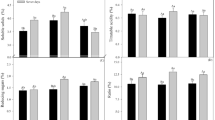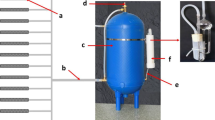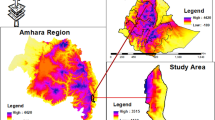Abstract
With rising concern about current irrigation and fertilizer NPK management, the present study was conducted to evaluate the effect of sources and methods of fertilizer application on nutrient distribution, uptake, recovery and fruit yield of tomato grown in a sandy soil. Equal amounts of NPK were applied in solid form or through fertigation at levels of 0%, 50%, 75% and 100% with the remainder 100%, 50% and 25% applied as solid fertilizers to the soil. Available NO3 −-N and K were confined to the root zone of tomato in 75% and 100% NPK fertigation levels, while they moved beyond the root zone when they applied in two equal splits as solid fertilizers with drip (0% fertigation) and furrow irrigation. The mobility of P was greater in the root zone following its application through fertigation compared to a solid application as super phosphate. Drip irrigation showed significantly higher absolute growth rate (AGR), total dry weight (TDW) and leaf area index (LAI) of tomato over furrow irrigation. Moreover, tomato plants were able to utilize applied nutrients more efficiently in fertigation system than with conventional solid fertilizer application. Highest AGR, TDW and LAI were recorded when nutrients were applied to 100% by drip fertigation. The fruit yield of tomato was higher with drip irrigation (58.62 t ha−1) than with furrow irrigation, (47.37 t ha−1). Maximum fruit yield was recorded with 100% NPK fertigation (74.87 t ha−1) and was associated with a higher number of fruits per plant and a bigger fruit size than the solid applied fertilizers under both drip and furrow irrigation. On average, tomato accumulated more NPK across the fertigation levels than with drip and furrow irrigation. Similarly, the more controlled application of nutrients in fertigation treatments improved NPK recovery and fertilizer use efficiency (FUE) and resulted in lesser leaching of NO3 −-N and K to deeper soil layers.
Zusammenfassung
Die Bedeutung des Bewässerungsmanagements und der NPK-Düngüng steigt stetig an. In einer Studie wurde die Wirkung der Düngerformen und der Anwendungsmethoden auf Nährstoff- Verteilung, -Aufnahme, und -Verwertung untersucht. Weiterhin wurde der Ertrag von Tomaten, die auf sandigem Boden angebaut wurden, untersucht.
Es wurden gleiche Mengen an NPK-Düngemittel ausgebracht (Fertigation* in Stufen von 0%, 50%, 75% und 100% und der Rest von 100%, 50%, 25% und 0% als feste Form). Verfügbares NO3 −-N und K wurde in der Wurzelzone von Tomaten bei einer Fertigationsstufe von 75% und 100% NPK gefunden, während bei einer Anwendung mit festem Düngemittel (0% Fertigation) und Furchenbewässerung sich NO3 −-N und K über die Wurzelzone hinaus bewegten.
Die Mobilität von P war größer bei einer Ausbringung durch Bewässerungsdüngung als bei einer Anwendung als Super-Phosphat. Tomaten der Tropfenbewässerung zeigten eine signifikant höhere absolute Wachstumsrate (AWR), Trockenmasse (TM) und einen signifikant höheren Blattflächenindex (LAI) gegenüber der Furchenbewässerung. Darüber hinaus waren die Tomatenpflanzen in der Lage bei der Bewässerungsdüngung die angewandten Nährstoffe effizienter zu nutzen, als bei der Düngung in herkömmlicher fester Form. Die höchsten AWR, TM und LAI wurden erfasst, wenn die Nährstoffe zu 100% in Form der Bewässerungsdüngung angewendet wurden. Der Ertrag der Tomaten war höher bei der Tropfenbewässerung (58,62 t ha−1), als bei der Furchenbewässerung (47,37 t ha−1). Die maximalen Erträge wurden mit 74,87 t ha−1 bei 100% NPK Fertigation erfasst und wurden mit einer höheren Anzahl der Früchte pro Pflanze begleitet. Zudem waren die Früchte der Tomaten größer, als bei der Anwendung fester Düngemittel (sowohl bei der Tropfenbewässerung, als auch bei der Furchenbewässerung). Im Durchschnitt, akkumulierten die Tomaten mehr NPK über die Fertigationstufen als bei den Bewässerungssystemen (Tropfen und Furche). Ähnlich verliefen auch die NPK-Verwertung und die Düngernutzungseffizienz: mit einer geringen Auswaschung von NO3 −-N und K in tiefen Bodenschichten.
Fertigation“ bzw. „Bewässerungsdüngung“ ist die Einspeisung der Dünger via Tropfenbewässerungssystem zu verstehen.



Similar content being viewed by others
References
Allen, RG, Pereira LS, Raes D, Smith M (1998) Crop evapotranspiration. Guidelines for computing crop water requirements. FAO irrigation and Drainage. Paper No. 56, FAO, Rome, Italy, p 300
Badr MA (2007) Spatial distribution of water and nutrients in root zone under surface and subsurface drip irrigation and cantaloupe yield. World J Agric Sci. 3(6):747–756
Bhat R, Sujatha S, Upadhyay AK, Ashalatha BV (2007) Phosphorus and potassium distribution as influenced by fertigation in arecanut rhizosphere. J Plant Cr 35(2):68–72
Boyhan GE, Kelley WT (2001) Onion production guide, Bulletin 1198. College of Agricultural and Environmental Sciences, University of Georgia, p 56
Bremner JM, Mulvaney CS (1982) Nitrogen-total. In: Page AL, Miller RH, Keeney DR (eds) Methods of soil analysis. Part II. 2nd ed. Agronomy Monograph 9. ASA, and SSSA, Madison, WI
Cassel SF, Sharmasakar S, Miller SD, Vance GF, Zhang R (2001) Assessment of drip and flood irrigation on water and fertilizer use efficiencies for sugar beets. Agric Water Manage 46:241–251
Chawla JK, Narda NK (2000) Growth parameters of trickle fertigated potato. Indian J Agric Sci 70(11):747–752
Dangler JM, Locascio S (1990) Yield of trickle-irrigated tomatoes as affected by time of N and K application. J Amer Soc Hort Sci 115:585–589
Drost D, Koenig R (2001) Improving onion productivity and N use efficiency with a polymer coated nitrogen source. In: Presented at the Western Management Conference, Salt Lake City, UT March 8–9
Eaton AD, Clesceri LS, Greenberg AE (1995) Standard methods for the examination of water and wastewater, 19th ed. Am Public Health Assoc, Washington, DC
El-Tohamy WA, El-Abagy HM, Abou-Hussein SD, Gruda N (2009) Response of Cape gooseberry (Physalis peruviana L.) to nitrogen application under sandy soil conditions. Ges Pfl 61(3–4):123–127
Gardenas A, Hopmans JW, Hanson BR, Simunek J (2005) Two-dimensional modeling of nitrate leaching for different fertigation strategies under micro-irrigation. Agric Water Manage 74:219–242
Grant CA, Flaten DN, Tamasiewicz DJ, Sheppard SC (2001) The importance of early season phosphorous nutrition. Can J Plant Sci 81:211–224
Hanson BR, Simunek J, Hopmans JW (2006) Evaluation of urea-ammonium-nitrate fertigation with drip irrigation using numerical modeling. Agric Water Manage 86:102–113
Hebbar SS, Ramachandrappa BK, Nanjappa HV, Prabhakar M (2004) Studies on NPK drip fertigation in field grown tomato (Lycopersicon esculentum Mill.). Europ J Agronom 21:117–127
Jackson ML (1973) Soil chemical analysis. Prentice-Hall India Private Limited, New Delhi
Kargbo D, Skopp J, Knudsen D (1991) Control of nutrient mixing and uptake by irrigation frequency and relative humidity. Agron J 83:1023–1028
Lara D, Adjanohoun A, Ruiz J (1996) Response of tomatoes sown in the non-optimal season to fertigation on a compacted red ferralitic soil. Cultivar Tropicales 17(1):8–9
Li J, Zhang J, Rao M (2004) Wetting patterns and nitrogen distributions as affected by fertigation strategies from a surface point source. Agric Water Manage 67:89–104
Locascio SJ, Hochmuth GJ, Rhoads FM, Olson SM, Smajstrla AG, Hanlon EA (1997) Nitrogen and potassium application scheduling effects on drip-irrigated tomato yield and leaf tissue analysis. Hort Sci 32(2):230–235
Machado RMA, Rosario MDO, Oliveira G, Portas CAM (2003) Tomato root distribution, yield and fruit quality under subsurface drip irrigation. Plant Soil 255:333–341
Mmolawa K, Or D (2000) Water and solute dynamics under a drip-irrigated crop: experiments and analytical model. Trans ASAE 43 (6):1597–1608
Or D, Coelho FE (1996). Soil water dynamics under drip irrigation: transient flow and uptake models. Trans ASAE 39(6):2017–2025
Patel N, Rajput TBS (2004) Fertigation-a technique for efficient use of granular fertilizer through drip irrigation. Agric Eng 85(2):50–54
Phene CJ, Davis KR, Mead RM, Yue R, Wu IP, Hutmacher RB (1994) Evaluation of a subsurface drip irrigation system after ten cropping seasons. ASAE Pap. 932560 (winter meeting, Chicago, IL). ASAE, St. Joseph, MI
Rivera RN, Duarte SN, De Miranda JH, Botrel TA (2006) Potassium modeling dynamics in the soil under drip irrigation: model validation. Eng Agric 26(2):388–394
Rubiez IG, Stroehlein JL, Oebeker NF (1991) Effect of irrigation method on urea phosphate reactions in calcareous soils. Commun Soil Sci Plant Anal 22:431–435
SAS Institute (1996) AS/STAT User’s Guide, Version 6, 12th ed. SAS Institute, Inc. Cary, North Carolina. pp 846
Scholberg J, McNeal BL, Boote KJ, Jones JW, Locascio SJ, Olson SM (2000) Nitrogen stress effects on growth and nitrogen accumulation by field-grown tomato. Agron J 92:159–167
Silber A, Xu G, Levkovitch I, Soriano S, Bilu A, Wallach R (2003) High fertigation frequency: the effects on uptake of nutrients, water and plant growth. Plant Soil 253(2):467–477
Singandhupe RB, Rao GG, Patil NG, Brahmanand PS (2003) Fertigation studies and irrigation scheduling in drip irrigation system in tomato crop (Lycopersicon esculentum L.). Europ J Agron 19:327–340
Singh AK, Chakraborty D, Mishra B, Singh DK (2002) Nitrogen and potassium dynamics in fertigation system. 17th WCSS, 14–21 August 2002, Thailand
Vasane SR, Bhoi PG, Patil AS, Tumbare AD (1996) Effect of liquid fertilizer through drip irrigation on yield and NPK uptake of tomato. J Maharashtra Agric Univ 21(3):488–489
Waddell JT, Gupta SC, Moncrief JF, Rosen CJ, Steele DD (1999) Irrigation and nitrogen management effects on potato yield, tuber quality and nitrogen uptake. Agron J 9:991–997
Zotarelli L, Scholberg JM, Dukes MD, Munoz-Carpena R, Icerman J (2009) Tomato yield, biomass accumulation, root distribution and irrigation water use efficiency on a sandy soil, as affected by nitrogen rate and irrigation scheduling. Agric Water Manage 96:23–34
Author information
Authors and Affiliations
Corresponding author
Rights and permissions
About this article
Cite this article
Badr, M., Abou Hussein, S., El-Tohamy, W. et al. Nutrient uptake and yield of tomato under various methods of fertilizer application and levels of fertigation in arid lands. Gesunde Pflanzen 62, 11–19 (2010). https://doi.org/10.1007/s10343-010-0219-5
Received:
Accepted:
Published:
Issue Date:
DOI: https://doi.org/10.1007/s10343-010-0219-5




